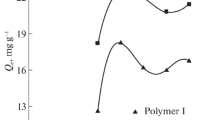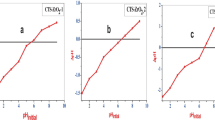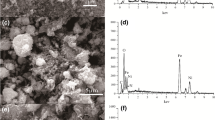Abstract
1:1 ZnO/Chitosan nanocomposite (nZnOCS nanocomposite) successfully prepared by sol–gel method and used as a sorbent for Cs(I) and Sr(II). The prepared samples characterized by different analytical techniques as FTIR, SEM, TEM, XRD, particle size analyzer, TGA/DTA, and pore size distribution. Optimization of pH of the medium, contact time, initial metal ion concentration and temperature for the sorption reaction performed. The sorption reaction kinetics follows pseudo-2nd order. The monolayer capacities at 298 K are 253.81 and 116.1 mgg−1 for Cs(I) and Sr(II), respectively. The sorption process is spontaneous and endothermic.














Similar content being viewed by others
References
Al Attar L, Safia B, Ghani BA (2018) Uptake of 137Cs and 85Sr onto thermally treated forms of bentonite. J Environ Radioact 193–194:36–43
Dakroury GA, Abo-Zahra SF, Hassan HS, Ali HEA (2020) Improvement of the sorption behavior of aluminum silicate composite toward 134Cs and 60Co radionuclides by non-living biomass of chlorella vulgaris. Environ Sci Pollut Res 27(17):21109–21125. https://doi.org/10.1007/s11356-020-08260-y
Ma F, Li Z, Zhao H, Geng Y, Zhou W, Li Q, Zhang L (2017) Potential application of graphene oxide membranes for removal of Cs(I) and Sr(II) from high level-liquid waste. Sep Purif Technol 188:523–529
Synhaeve N, Stefani J, Tourlonias E, Dublineau I, Bertho JM (2011) Biokinetics of 90Sr after chronic ingestion in a juvenile and adult mouse model. Radiat Environ Biophys 50:501–511
Chegrouche S, Mellah A, Barkat M (2009) Removal of strontium from aqueous solutions by adsorption onto activated carbon: kinetic and thermodynamic studies. Desalination 235:306–318. https://doi.org/10.1016/j.desal.2008.01.018
Ibrahim HA, Hassan HS, Mekhamer HS, Kenawy SH (2019) Diffusion and sorption of Cs+ and Sr2+ ions onto synthetic mullite powder. J Radioanal Nucl Chem 319:1–12
Hu YM, Guo X, Chen C, Wang JL (2019) Algal sorbent derived from sargassum horneri for adsorption of cesium and strontium ions: equilibrium, kinetics, and mass transfer. Appl Microbiol Biotechnol 103:2833–2843
Wang JL, Chen C (2014) Chitosan-based biosorbents: modification and application for biosorption of heavy metals and radionuclides. Bioresour Technol 160:129–141
Dakroury GA, Abo-Zahra SF, Hassan HS (2020) Utilization of olive pomace in nano MgO modification for sorption of Ni(II) and Cu(II) metal ions from aqueous solutions. Arab J Chem 13(8): 6510–6522, ISSN 1878-5352 https://doi.org/10.1016/j.arabjc.2020.06.008.
Huang KS, Yang CH, Huang SL, Chen CY, Lu YY, Lin YS (2016) Recent advances in antimicrobial polymers: a mini-review. Int J Mol Sci 17(9):1578–1592
Farzana MH, Meenakshi S (2015) Photocatalytic aptitude of titanium dioxide impregnated chitosan beads for the reduction of Cr(VI). Int J Biol Macromol 72:1265–1271
Kandile NG, Mohamed HM, Mohamed MI (2015) New heterocycle modified chitosan adsorbent for metal ions (II) removal from aqueous systems. Int J Biol Macromol 72:110–116. https://doi.org/10.1016/j.ijbiomac.2014.07.042
Xiaodong M, Zhang Z, Dai E, Guo H (2016) Improved multi-shot diffusion imaging using GRAPPA with a compact kernel. NeuroImage 138:88–99. https://doi.org/10.1016/j.neuroimage.2016.05.079
Shahzad A, Miran W, Rasool K, Nawaz M, Jang J, Le LS (2017) Heavy metals removal by EDTA-functionalized chitosan graphene oxide nanocomposites. RSC Adv 7:9764–9771. https://doi.org/10.1039/C6RA28406J
Zhang F, Chen X, Wu F, Ji Y (2016) High adsorption capability and selectivity of ZnO nanoparticles for dye removal. Coll Surf A Physicochem Eng Asp 509:474–483. https://doi.org/10.1016/j.colsurfa.2016.09.059
Zak AK, Abd Majid WH, Mahmuodian MR, Majid D, Yousefi R (2013) Starch-stabilized synthesis of ZnO nanopowders at low temperature and optical properties study. Adv Powder Technol 24(3):618–624. https://doi.org/10.1016/j.apt.2012.11.008
Rahman PM, Abdul Mujeeb VM, Muraleedharan K, Thomas SK (2018) Chitosan/nano ZnO composite films: Enhanced mechanical, antimicrobial and dielectric properties. Arab J Chem 11(1):120–127, ISSN 1878-5352 https://doi.org/10.1016/j.arabjc.2016.09.008
Abdelhady MM (2012) Preparation and characterization of chitosan / zinc oxide nanoparticles for imparting antimicrobial and UV protection to cotton fabric. Int J Carbohydr Chem 2012:1–6. https://doi.org/10.1155/2012/840591
Al-Naamani L, Dobretsov S, Dutta J (2016) Chitosan-zinc oxide nanoparticle composite coating for active food packaging applications. Innov Food Sci Emerg Technol 38:231–237. https://doi.org/10.1016/j.ifset.2016.10.010
Zhong R, Zhong Q, Huo M, Yang B, Li H (2020) Preparation of biocompatible nano-ZnO/chitosan microspheres with multi-functions of antibacterial, UV-shielding and dye photodegradation. Int J Biol Macromol 146:939–945. https://doi.org/10.1016/j.ijbiomac.2019.09.217
Yusof NAA, Zain NM, Pauzi N (2019) Synthesis of ZnO nanoparticles with chitosan as stabilizing agent and their antibacterial properties against Gram-positive and Gram-negative bacteria. Int J Biol Macromol 124:1132–1136. https://doi.org/10.1016/j.ijbiomac.2018.11.228
Saad AHA, Azzam AM, El-Wakeel ST, Mostafa BB, Abd El-lati MB (2018) Removal of toxic metal ions from wastewater using ZnO@Chitosan coreshell nanocomposite. Environ Nanotechnol Monit Manag 9:67–75. https://doi.org/10.1016/j.enmm.2017.12.004
Mohan AC, Renjanadevi B (2016) Preparation of zinc oxide nanoparticles and its characterization using scanning electron microscopy (SEM) and X-Ray diffraction (XRD). Procedia Technol 24:761–766. https://doi.org/10.1016/j.protcy.2016.05.078
Lin J, Wang L (2009) Comparison between linear and non-linear forms of pseudo-first-order and pseudo-second-order adsorption kinetic models for the removal of methylene blue by activated carbon. Front Environ Sci Eng China 3:320–324. https://doi.org/10.1007/s1783-009-0030-7
Cheung CW, Porter JF, Mckay G (2000) Sorption kinetics for the removal of copper and zinc from effluents using bone char. Sep Purif Technol 19(1–2):55–64 http://hdl.handle.net/1783.1/24689
Weber WJ, Morris JC (1963) Kinetics of adsorption on carbon from solution. J Sanit Eng Div, Am Soc Civ Eng 89(2):31–60
Dakroury GA, Abo-Zahra ShF (2020) The use of titanium oxide/polyethylene glycol nanocomposite in sorption of 134Cs and 60Co radionuclides from aqueous solutions. J Radioanal Nucl Chem 324:1351–1364. https://doi.org/10.1007/s10967-020-07167-9
Lima EC, Hosseini-Bandegharaei A, Moreno-Piraján JC, Anastopoulos I (2018) A critical review of the estimation of the thermodynamic parameters on adsorption equilibria. Wrong use of equilibrium constant in the Van’t Hoof equation for calculation of thermodynamic parameters of adsorption. J Mol Liq 273:425–434. https://doi.org/10.1016/j.molliq.2018.10.048
Ayawei N, Ebelegi AN, Wankasi D (2017) Modelling and interpretation of adsorption isotherms. J Chem 2017:1–11. https://doi.org/10.1155/2017/3039817
Khezami L, Taha KK, Modwi A (2017) Efficient removal of cobalt from aqueous solution by zinc oxide nanoparticles: kinetic and thermodynamic studies". Zeitschrift für Naturforschung 72(5):409–418. https://doi.org/10.1515/zna-2016-0477
Lefatshe K, Muiva CM, Kebaabetswe LP (2017) Extraction of Nanocellulose and In-Situ Casting of ZnO/Cellulose Nanocomposite with Enhanced Photocatalytic and Antibacterial Activity. Carbohydr Polym 164:301–308. https://doi.org/10.1016/j.carbpol.2017.02.020
Abdelrehim MM, Mohy ElDin MH, El-Shabrawy SM, Fahmy AE, Abdelhamid SM, Ramadan HS (2019) Synthesis and characterization of metallic and polymeric nanoparticles and their effect on the antibacterial properties of microhybrid composite resin. Alexandria Dental J Article 7 44(2):39–45. https://doi.org/10.21608/ADJALEXU.2019.57361
Prokhorov E, Luna-Bárcenas G, Yáñez LJM, Sánchez AG, Kovalenko Y (2020) Chitosan-ZnO nanocomposites assessed by dielectric, mechanical, and piezoelectric properties. Polymers 12(9):1991–2005. https://doi.org/10.3390/polym12091991
Zak AK, Abd. Majid WH, Mahmoudian MR, Darroudi M, Yousefi R (2013) Starch-stabilized synthesis of ZnO nanopowders at low temperature and optical properties study. Adv Powder Technol 24(3):618–624. https://doi.org/10.1016/j.apt.2012.11.008
Sagadevan S, Vennila S, Anita Lett J, Marlinda AR, Aliya Binti Hamizi N, Rafie Johan M (2019) Tailoring the structural, morphological, optical, thermal and dielectric characteristics of ZnO nanoparticles using starch as a capping agent. Results in Physics 15 (2019) 102543 ISSN 2211-3797 https://doi.org/10.1016/j.rinp.2019.102543.
Hassan HS, Attia LA, Dakroury GA (2020) Exploration of the parameters affecting the radioactive europium removal from aqueous solutions by activated carbon-epoxy composite. Appl Radiat Isot 164:109278. https://doi.org/10.1016/j.apradiso.2020.109278
Puigdomenech I (2013) Make equilibrium diagrams using sophisticated algorithms (MEDUSA). Inorganic Chemistry Royal Institute of Technology Stockholm Sweden. http://www.kemi.kth.se/medusahttps://sites.google.com/site/chemdiagr/
Hasan S, Iasir ARM, Ghosh TK, Gupta BS, Prelas MA (2019) Characterization and adsorption behavior of strontium from aqueous solutions onto chitosan-fuller’s earth beads. Healthcare 7(1):52. https://doi.org/10.3390/healthcare7010052
Al-Senani GM, Al-Fawzan FF (2019) Adsorption study of heavy metal ions from aqueous solution by nanoparticle of wild herbs. Egypt J Aquat Res 44(3):187–194 ISSN 1687-4285, https://doi.org/10.1016/j.ejar.2018.07.006
Zhang N, Liu S, Jiang L, Luo M, Chi C, Ma J (2015) Adsorption of strontium from aqueous solution by silica mesoporous SBA-15. J Radioanal Nucl Chem 303:1671–1677. https://doi.org/10.1007/s10967-014-3681-1
Robati D (2013) Pseudo-second-order kinetic equations for modeling adsorption systems for removal of lead ions using multi-walled carbon nanotube. J Nanostruct Chem 3(1):55. https://doi.org/10.1186/2193-8865-3-55
Igwe JC, Abia AA (2007) Adsorption isotherm studies of Cd (II), Pb (II) and Zn (II) ions bioremediation from aqueous solution using unmodified and EDTA-modified maize cob. Eclética Química 32(1):33–42. https://doi.org/10.1590/S0100-46702007000100005
Li D, Zhang B, Xuan F (2015) The sequestration of Sr(II) and Cs(I) from aqueous solutions by magnetic graphene oxides. J Mol Liq 209:508–514. https://doi.org/10.1016/j.molliq.2015.06.022
Tan Y, Feng J, Qiu L, Zhao Z, Zhang X, Zhang H (2017) The adsorption of Sr(II) and Cs(I) ions by irradiated Saccharomyces cerevisiae. J Radioanal Nucl Chem 314:2271–2280. https://doi.org/10.1007/s10967-017-5598-y
Lee CH, Park JM, Lee MG (2014) Adsorption characteristics of Sr(II) and Cs(I) ions by zeolite synthesized from coal fly ash. Int J Environ Sci 23(12):1987–1998. https://doi.org/10.5322/JESI.2014.23.12.1987
Ali MMS, Sami NM, El-Sayed AA (2020) Removal of Cs+, Sr2+ and Co2+ by activated charcoal modified with Prussian blue nanoparticle (PBNP) from aqueous media: kinetics and equilibrium studies. J Radioanal Nucl Chem 324:189–201. https://doi.org/10.1007/s10967-020-07067-y
Chen C, Wang J (2008) Removal of Pb2+, As+, Cs+ and Sr2+ from aqueous solution by brewery’s waste biomass. J Hazard Mater 151:65–70. https://doi.org/10.1016/j.jhazmat.2007.05.046
Uematsu Y, Ogata F, Saenjum C, Nakamura T, Kawasaki N (2020) Removing Sr(II) and Cs(I) from the aqueous phase using basil seed and elucidating the adsorption mechanism. Sustainability 12(7):2895. https://doi.org/10.3390/su12072895
Author information
Authors and Affiliations
Contributions
All authors contributed to the study conception and design. Material preparation, data collection and analysis. All authors read and approved the final manuscript.
Corresponding author
Ethics declarations
Conflict of interest
The authors declare that they have no conflict of interest.
Additional information
Publisher's Note
Springer Nature remains neutral with regard to jurisdictional claims in published maps and institutional affiliations.
Rights and permissions
About this article
Cite this article
Dakroury, G.A., El-Shazly, E.A.A. & Hassan, H.S. Preparation and characterization of ZnO/Chitosan nanocomposite for Cs(I) and Sr(II) sorption from aqueous solutions. J Radioanal Nucl Chem 330, 159–174 (2021). https://doi.org/10.1007/s10967-021-07935-1
Received:
Accepted:
Published:
Issue Date:
DOI: https://doi.org/10.1007/s10967-021-07935-1




